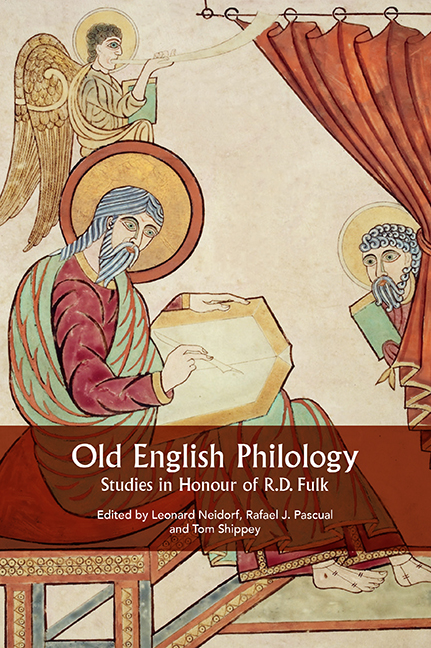Book contents
- Frontmatter
- Contents
- List of Illustrations
- Acknowledgements
- List of Contributors
- Introduction: R.D. Fulk and the Progress of Philology
- 1 Sievers, Bliss, Fulk, and Old English Metrical Theory
- 2 Ictus as Stress or Length: The Effect of Tempo
- 3 Metrical Criteria for the Emendation of Old English Poetic Texts
- 4 The Suppression of the Subjunctive in Beowulf: A Metrical Explanation
- 5 Metrical Complexity and Verse Placement in Beowulf
- 6 Alliterating Finite Verbs and the Origin of Rank in Old English Poetry
- 7 Prosody-Meter Correspondences in Late Old English and Poema Morale
- 8 The Syntax of Old English Poetry and the Dating of Beowulf
- 9 The Anglo-Saxons and Superbia: Finding a Word for it
- 10 Old English gelōme, gelōma, Modern English loom, lame, and Their Kin
- 11 Worm: A Lexical Approach to the Beowulf Manuscript
- 12 Wulfstan, Episcopal Authority, and the Handbook for the Use of a Confessor
- 13 Some Observations on e-caudata in Old English Texts
- 14 The Poetics of Poetic Words in Old English
- 15 Dream of the Rood 9b: A Cross as an Angel?
- 16 The Fate of Lot’s Wife: A ‘Canterbury School’ Gloss in Genesis A
- 17 Metrical Alternation in The Fortunes of Men
- 18 The Originality of Andreas
- 19 The Economy of Beowulf
- 20 Beowulf Studies from Tolkien to Fulk
- The Writings of R.D. Fulk
- Index
- Tabula Gratulatoria
- Anglo-Saxon Studies
16 - The Fate of Lot’s Wife: A ‘Canterbury School’ Gloss in Genesis A
Published online by Cambridge University Press: 29 May 2021
- Frontmatter
- Contents
- List of Illustrations
- Acknowledgements
- List of Contributors
- Introduction: R.D. Fulk and the Progress of Philology
- 1 Sievers, Bliss, Fulk, and Old English Metrical Theory
- 2 Ictus as Stress or Length: The Effect of Tempo
- 3 Metrical Criteria for the Emendation of Old English Poetic Texts
- 4 The Suppression of the Subjunctive in Beowulf: A Metrical Explanation
- 5 Metrical Complexity and Verse Placement in Beowulf
- 6 Alliterating Finite Verbs and the Origin of Rank in Old English Poetry
- 7 Prosody-Meter Correspondences in Late Old English and Poema Morale
- 8 The Syntax of Old English Poetry and the Dating of Beowulf
- 9 The Anglo-Saxons and Superbia: Finding a Word for it
- 10 Old English gelōme, gelōma, Modern English loom, lame, and Their Kin
- 11 Worm: A Lexical Approach to the Beowulf Manuscript
- 12 Wulfstan, Episcopal Authority, and the Handbook for the Use of a Confessor
- 13 Some Observations on e-caudata in Old English Texts
- 14 The Poetics of Poetic Words in Old English
- 15 Dream of the Rood 9b: A Cross as an Angel?
- 16 The Fate of Lot’s Wife: A ‘Canterbury School’ Gloss in Genesis A
- 17 Metrical Alternation in The Fortunes of Men
- 18 The Originality of Andreas
- 19 The Economy of Beowulf
- 20 Beowulf Studies from Tolkien to Fulk
- The Writings of R.D. Fulk
- Index
- Tabula Gratulatoria
- Anglo-Saxon Studies
Summary
In the Old English Genesis A, the poet describes how Lot's wife was turned into a sealtstān, adding that she must remain in that place until the Lord decides her fate at the Last Judgment:
þā þæt fȳrgebræc,
lēoda līfgedāl, lōthes gehȳrde
brȳd on burgum, under bæc beseah
wið þæs wælfylles. ūs gewritu secgað
þæt heo on sealtstānes sōna wurde
anlīcnesse. ǣfre siððan
se monlīca, þæt is mǣre spell,
still wunode þǣr hīe strang begeat
wīte þæs hēo wordum wuldres þegna
hȳran ne wolde. Nu sceal heard and stēap
on þām wīcum wyrde bīdan,
drihtnes dōmes hwonne dōgora rīm,
woruld gewīte (11. 2562b–74a, ed. Doane 2013: 261)
When Lot's wife heard that crash of fire among the cities, the parting from life of peoples, she looked back at the destruction. Writings tell us that she was immediately turned into a likeness of a stone of salt. Ever since, that human likeness (that is a famous tale) has stood motionless where the severe punishment befell her because she did not wish to obey the words of the thanes of glory. Now, hardened and projecting, she must await fate in that place, the judgment of the Lord when the count of days, the world passes away.
The Vulgate says that Lot's wife “was turned into a statue of salt” (versa est in statuam salis, Gen. 19:26), which the poet renders as sealtstānes anlīcnes. OE anlīcnes can refer to a statue – as it does here insofaras it corresponds to Vulgate statua – but always as a specification of its base meaning “likeness” or “image,” which designates a representation of something else. Here it is a “likeness” made of sealtstān (material genitive), but also a “likeness” of a sealtstān (genitive of comparison), for it is not a natural formation. At the same time it is a monlīica, a “likeness” of what had been a human being. For medieval Christians the human was defined by the book of Genesis as “the image and likeness” of God (Faciamus hominem ad imaginem et similitudinem 0nostram, Gen. 1:26), and both Latin imago and similitudo were regularly translated by anlicnes in Old English.
- Type
- Chapter
- Information
- Old English PhilologyStudies in Honour of R.D. Fulk, pp. 292 - 310Publisher: Boydell & BrewerPrint publication year: 2016
- 2
- Cited by



